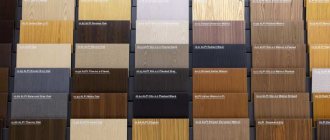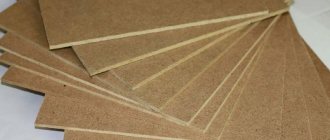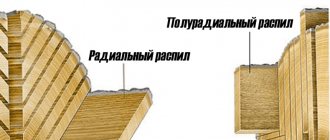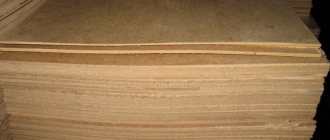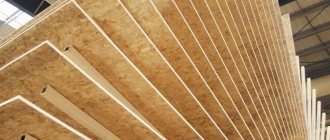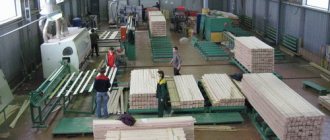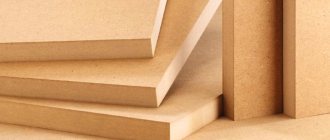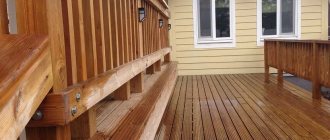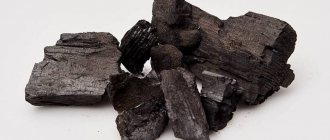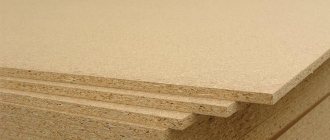Types of lumber
Waste sawn material comes in two types:
- Business.
- Wood-burning.
Industrial wood has a thickness of at least 35 mm . Structures of various shapes are made from it. Lumber can be unprocessed - with bark. Wood, cleared of bark, is used for cladding building structures.
Firewood lumber is processed . Some boards are used as firewood. Wood chips are made from it. Briquettes are made from wood chips for lighting stoves and boilers. Wood chips are used to sprinkle paths in the garden and strengthen the soil foundation in greenhouses and conservatories. Firewood is shown in the bottom photo.
What is a croaker?
It is a one-sided convex board with a surface of strictly standardized thickness, completely sawn (or not sawn) along its entire length, starting from the wider edge. It is the side part of a log with or without bark, a remnant of the woodworking process. As a percentage, its share is 1/10 of the total volume of feedstock.
Business croaker
How to produce
Waste lumber is obtained by processing tree trunks. In industrial conditions, logs are sawed using complex machine equipment with four saw blades. Numerical control is configured in such a way that the logs are cut simultaneously from four sides. The required thickness of the slab and the maximum length of the cut are set.
There are double-sided longitudinal planing machines . First, two opposite sides of the trunk are processed, then the workpiece is rotated 90˚ along the longitudinal axis and the separation of the outer layer of the tree continues.
The trading network has different types of sawing machines for large workshops. It is beneficial to keep the equipment for work in the household.
Processing methods
For those who earn money by sawing logs into boards, slab is a waste product that must be disposed of in any way. However, it can be processed into much more expensive and sought-after materials.
In most cases
, processing includes :
Sawing is the main operation that is used in most processing methods and is carried out using saws or circular saws.
These mechanisms differ from each other only in that in a cutting machine the slab is fed to the saw by a special tracked or gear drive, and when working with a circular saw, the operator independently pushes the board being processed forward.
For planing, thicknessing and milling, they use both a universal machine, switching its operating modes, and various highly specialized machines.
The principle of wood processing in these operations is the same - a shaft rotating at high speed with knives mounted on it cuts through the wood.
By changing the knives to shaped ones, you can mill the surfaces into any shape. By changing the distance between the receiving table and the shaft, you can thickness the material, after which you get a board of a given thickness, both planes of which are smooth (planed).
For gluing, modern adhesives are used, which, after hardening, acquire strength comparable to wood. Using gluing, beams and panels of any size/section are made from small planed bars.
Another way of processing is to clear the material from the bark. This operation is performed manually or using various machines.
Most often, debarking is carried out when preparing a finishing or decorative slab, when it is necessary to preserve the texture and relief of the original wood as much as possible.
In cases where the quality or size of the slab does not allow it to be processed into something more in demand, it can be cut into firewood or crushed into chips, which will be useful in the garden or vegetable garden, and will also find many other uses.
As a result of processing slab, the following products or products are obtained:
More detailed information on processing methods and equipment used for this can be found here.
Kinds
The value of business waste lumber depends on the type of wood being processed. For example, birch, spruce, and aspen boards are used in construction as auxiliary materials.
Products made from larch, oak and other valuable wood species are expensive. Such raw materials are classified as the highest category. It is used as a finishing material.
Fencing for garden beds
With the onset of planting season, every gardener strives to organize the garden space as rationally as possible. You can outline smooth, neat beds using a slab. Such fencing not only makes planting more orderly, but also helps combat excessive water consumption and weed infestation. It is easier to attach covering material to a wooden support during frosts and arcs to support climbing crops during the period of active growth.
The board can be placed horizontally along the perimeter of the entire ridge, or it can be cut into small posts of the same height, which are used to cover the finished frame. The result is an imitation of a log fence.
Due to constant contact with water, croakers of moisture-resistant species are used to arrange the beds. You can use oak, larch, ash. Pine boards have a shorter service life, but are also suitable for temporary fencing.
Application
Industrial lumber is used as construction timber for the manufacture of:
- fences and fences;
- registration of personal buildings;
- formwork;
- roofs;
- pallets;
- garden furniture;
- gazebos;
- designer furniture in loft style;
- cladding of enclosing structures;
- linings;
- crafts.
Fences and enclosures
Fences and enclosures made from wood waste provide owners of private farms with significant savings. Timber does not require special conditions for storage and construction. The slab is nailed in a vertical position to the transverse slats between the support posts. It is placed horizontally, filling the openings between the racks. The croaker, cleared of bark, is impregnated with antiseptics and covered with varnish or stain.
Low fences define the boundaries of plots of land planted with different crops. The boards can be dug into the ground by first wrapping their lower part with roofing felt or roofing felt. This type of fencing can last for a long time.
Formwork
It is advantageous to use waste lumber as formwork. It can be made very quickly for small monolithic foundation structures from slabs. Wood-burning lumber is suitable for making fences for liquid concrete . The removed formwork is used as fuel for lighting stoves, boilers and fireplaces.
Roof
Supporting structures made from slabs under roof cladding boards significantly reduce the cost of construction. The load-bearing capacity of such a roof is in no way inferior to structures made from factory-made profiles.
Pallets
The horizontal planes of the pallets, made from slabs, are connected with pieces of timber and nailed. Such boards are not used in industrial production. Pallets are made for the needs of private households in their workshops. They are convenient for storing building materials and barrels of salting.
Country furniture
The backs and seats of garden benches are covered with bark-free material. To protect the wood from exposure to the atmosphere, it is coated with varnish for exterior use.
From waste wood they knock together bases for sleeping mattresses and make bedside tables. At the dacha, interior partitions are made from boards.
Gazebos and canopies made of slab
Gazebos and canopies, sheathed inside and outside with slabs, have an original, exotic look. The frame of the structure is a rectangular structure, the main element of which is the slab. To ensure rigidity of the structure, boards with a thickness of at least 40 mm are used. The frame of the gazebo is sheathed with a slab - it does not bear the main load.
The roof of the gazebo is covered with a slab. Although this is not necessary, traditional roofing materials are usually used.
Designer furniture in loft style
Recently, the loft style in interior design has become popular. The fashion trend has affected furniture. It is better to make countertops from oak boards or larch. You can use lumber from other types of wood.
Select wood with a uniform profile . The bark is removed, sanded and varnished. Strongly protruding branches are cut off. Gaps between boards and uneven surfaces are filled with epoxy resin mixed with fluorescent powder. A luminous table will decorate the veranda, country kitchen or living room.
Cladding of enclosing structures
Finishing walls and ceilings with slabs made of valuable wood creates an atmosphere of closeness to nature inside both residential and public premises. A sheathing of timber or slats is installed along the planes of the fences. The choice of sheathing profile depends on the thickness of the slab. The boards are nailed with small nails, driving them into the edges.
Cleaned boards are used to decorate walls and ceilings in rooms with high humidity levels (baths, saunas). Walls covered with coniferous boards (pine, spruce) constantly spread the aroma of resin, which acts in the same way as a disinfectant.
Lining
It is quite rare to make slab lining with your own hands. It all depends on the quality of the source material. The thicker the boards, the greater the chances of producing high-quality lining. The height of the cross-section of the wood should allow the raw material to be sawed so that grooves and tenons with a thickness and width of at least 10 mm are obtained. Otherwise, the wall cladding will turn out fragile and unreliable.
Lining is used to cover the surfaces of walls and ceilings in the steam room of a bathhouse . The products are used to cover rooms both inside houses and outside facades. The boards are fastened to the wooden sheathing with clamps or nailed.
Crafts
Among the waste from sawing timber there will always be short pieces of slab. You can cut out crafts from them.
Various openings in the fences indoors are framed with a figured slab. A coat rack looks beautiful on the wall, the base of which consists of a row of slabs with hooks for clothes.
Craftsmen use waste lumber from valuable wood to make various souvenirs.
Where is croaker used?
It is involved in a considerable number of industrial, agricultural and construction processes, being a widely available basis for:
- fences, fencing;
- linings;
- sheathing strip;
- subfloor;
- wall materials for houses made of timber;
- design elements;
- ceilings;
- formwork;
- design of openings and openings;
- finishing beds and flower beds;
- small building elements;
- pallets;
- benches, tables, etc.
Slab fence
Advantages
The advantages of the slab are as follows:
- The cheapest lumber. Its use as load-bearing elements brings significant cost savings when constructing lightweight buildings.
- The low weight of the boards when constructing small objects allows you to create cheap foundations.
- Cladding with slabs does not require additional finishing of building structures. Walls covered with decorative wood carry an aesthetic value.
- Barked surfaces are varnished or painted, which gives the furniture a special appeal.
- The ease of installation of lumber does not cause difficulties when carrying out facing work.
- Wood waste is widely used in the manufacture of various products - from parquet to the design of accent walls.
- Using industrial wood as lining will allow you to avoid unnecessary costs for purchasing a factory profile.
Barn
Utility rooms for storing shovels, rakes, watering cans and other garden utensils are small in size and have minimal design requirements. They are erected without a foundation on several supports made of rolled metal or wooden beams.
In most cases, it is enough to assemble a frame of 2.5 x 1.5 meters, erect walls up to 2 meters in height and equip a pitched roof. Sanded slabs are used for the walls. The boards are attached to the support with an overlap, this allows you to avoid gaps and hide the screw heads. It is also used for the roof frame.
Calculation of material quantity
To count, measure the perimeter and count the number of pillars taking into account the selected interval. The gate is 1 m wide; you will also need 2 posts to hang it. The supports for installing the gate are counted. If the gate is located in the gate leaf, wood is added to the support frame in the leaf.
The perimeter is multiplied by the height of the fence and the area of the fence is obtained. Divide the square by the conditional area of one slab board (sellers will tell you the value), and calculate the approximate number of elements. The material is taken in reserve so as not to buy additional boards. It is known from practice that the resulting number is multiplied by a factor of 1.2 to take into account the processing of knots and cutting to size.
Firewood from sawing waste
In cases where it is impossible to get normal firewood from hard deciduous trees, but you already need to heat a stove or boiler, you can use firewood from slabs.
There is no document regulating the characteristics of a wood-burning slab.
However, when using fuel from waste logs, it is necessary to understand how they behave as firewood, as well as what their characteristics depend on. The most important parameter is the species , because croaker retains all the properties of the original wood.
After cutting down a tree, the sap flow stops completely, but the sap in the wood does not disappear anywhere. Over time, it loses moisture, like the wood around it, and the resins and nutrients remain inside the wood fibers.
When wood burns, several processes occur simultaneously:
The intensity of these processes , as well as the amount of toxic substances released during the combustion process, depends on three main factors :
The higher the humidity of the firewood, the lower the combustion temperature in any mode, because part of the thermal energy will be spent on the evaporation of water filling the wood fibers.
At the same time, the calorific value of most coniferous wood is noticeably lower than that of deciduous wood, which is why wet coniferous firewood gives noticeably worse results than wet deciduous wood.
In addition, coniferous species contain much more resins , which, when exposed to high temperatures, turn into volatile compounds. When smoke passes through a cold chimney, condensation, consisting of water, soot and various derivatives of tree resins, forms on its walls.
Considering that deciduous firewood is made from dead wood with a minimum level of moisture, firewood from softwood slabs is not only more humid, but also contains more resins, as a result of which burning them leads to rapid overgrowing of the chimney walls with soot.
The speed of this process can only be reduced by thoroughly drying the sawn firewood , for which they are kept in a ventilated barn for at least a year, and by heating the firebox at maximum power.
After all, the higher the temperature of the smoke in the chimney, the less steam will settle on its walls in the form of condensation, which means the smaller the layer of soot and resin mixture will be. More detailed information about firewood from slabs and the features of their use can be found in the article about firewood from slabs.
Brick fence
The construction of a brick fence is a responsible job and requires compliance with certain rules. But the owner receives for his efforts a high-strength, beautiful fence with a long service life. A rich assortment of bricks allows you to create a fence that organically complements any exterior.
A properly constructed brick fence can withstand even a hurricane!
We build a brick fence at the dacha as follows:
- We measure the length of the future structure and create an estimate for materials.
- We mark the territory and dig holes for the strip foundation.
- We fill the base as soon as the support pillars are installed.
- To avoid the formation of joints and increase the strength of the structure, we make the foundation in one approach.
- We are laying bricks on the frozen foundation. We arrange them in one row, but if you want to show creativity, we use combined or openwork variations. For a high fence we make double-row masonry.
If you have never worked with brick, hire a specialist to build a fence, since laying the material requires meticulousness and control of the evenness and thickness of the seams. In the absence of sufficient experience, the design may turn out to be sloppy and weakly stable.
Price
In order for further processing to be profitable, it is necessary to clearly understand what factors determine the cost of this material and whether it can be purchased cheaper.
For those who cut logs into boards, it is more important to sell the scraps at the maximum price, because they are part of the log for which a lot of money was paid.
In addition, it is necessary to take into account transportation costs , which increase as the volume of material transported increases, and as the distance from the supplier to the buyer or processor increases.
If you are interested in the formation of the cost of slabs and related issues, then you will find a lot of useful information here.
Processing methods
For those who earn money by sawing logs into boards, slab is a waste product that must be disposed of in any way. However, it can be processed into much more expensive and sought-after materials.
In most cases
, processing includes :
Sawing is the main operation that is used in most processing methods and is carried out using saws or circular saws.
These mechanisms differ from each other only in that in a cutting machine the slab is fed to the saw by a special tracked or gear drive, and when working with a circular saw, the operator independently pushes the board being processed forward.
For planing, thicknessing and milling, they use both a universal machine, switching its operating modes, and various highly specialized machines.
The principle of wood processing in these operations is the same - a shaft rotating at high speed with knives mounted on it cuts through the wood.
By changing the knives to shaped ones, you can mill the surfaces into any shape. By changing the distance between the receiving table and the shaft, you can thickness the material, after which you get a board of a given thickness, both planes of which are smooth (planed).
For gluing, modern adhesives are used, which, after hardening, acquire strength comparable to wood. Using gluing, beams and panels of any size/section are made from small planed bars.
Another way of processing is to clear the material from the bark. This operation is performed manually or using various machines.
Most often, debarking is carried out when preparing a finishing or decorative slab, when it is necessary to preserve the texture and relief of the original wood as much as possible.
In cases where the quality or size of the slab does not allow it to be processed into something more in demand, it can be cut into firewood or crushed into chips, which will be useful in the garden or vegetable garden, and will also find many other uses.
As a result of processing slab, the following products or products are obtained:
More detailed information on processing methods and equipment used for this can be found here.
Interesting wooden fences: photos and design features
Fences made of wood have a certain design. The photo shows individual elements of the device. The fence is made from certain components: transverse logs, supporting elements and a picket fence.
Fences can be made in a variety of configurations
You can install the fence yourself. To do this, you need to select the right materials and install supporting elements. For strong racks of the structure, profiled metal pipes or wooden beams are used. Wooden parts require additional processing. The part that is dug into the ground must be covered with bitumen mastic. In addition, the beam is additionally treated with antiseptic agents. To protect iron parts, you need to remove rust, prime the surface and paint it with frost-resistant paint.
Unusual designs, as a rule, are difficult to manufacture and high in price.
Photos of wooden picket fences: design features
To choose a suitable design, you can look at photos of wooden picket fences. Such designs have the following advantages:
- made from different types of wood;
- such designs are distinguished by their originality and attractive appearance;
- combine with any type of landscape design;
- combined with various bases: stone, brick, metal or concrete;
- characterized by durability and strength;
- installation work is simple.
The picket fence is a universal solution for all cases
Picket fence products require simple care. They require quality painting every year.
Construction of a simple picket fence
Board fences: photos and advantages
Fences made of boards are especially in demand. The photo allows you to see the most interesting options. They have the following advantages:
- goes well with any setting;
- environmental friendliness of materials;
- affordable price;
- ease of installation;
- durability and strength;
- large selection of original models.
Any fencing designs can be created from boards
You can make such a fence yourself. To do this, take several pegs that are driven into the ground around the perimeter of the site. Then the boards are prepared. These elements can be made in any convenient shape. In place of the pegs, recesses are drilled into which supports for the fence are placed. The racks are made of beams. They are placed in prepared holes and covered with earth. The veins are nailed down using nails. Then the boards are installed tightly to each other. Then the surface of the structure is covered with drying oil or paint.
Unedged boards are used to decorate a rustic exterior
Video: decorative fencing made of unedged boards
How to make wooden fences on metal posts correctly
High wooden fences on metal posts are especially durable. Wood of such structures is treated with special impregnations. Metal poles are easy to install and have a long service life. For their manufacture, pipes of various profiles are selected.
Construction of a structure on metal poles
Metal supports can be installed in different ways:
- the pipes are driven into the ground, while the verticality of the element is checked;
- a well is drilled in the soil and supports are installed into it, which are well compacted;
- Concreting of each pillar is carried out;
- a concrete base is installed into which metal racks are installed.
Methods for installing metal poles
An example of the simplest design on metal supports
